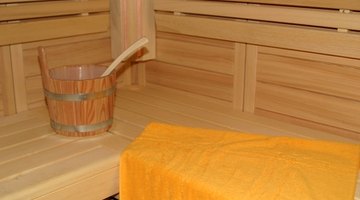Basswood Vs. Cedar for Sauna
Saunas are used as part of an invigorating detoxification process by many people. The environment, however, which includes high temperatures and sometimes dampness induced by introducing water to the heating elements, can warp, twist or crack woods. Cedar and basswood resist distortion and thus are good choices for saunas. The main difference between the two woods for saunas is that cedar emits a fragrance and basswood does not.
Facts

Several stable species of wood , like hemlock and polar, are used to construct saunas but cedar and basswood are the most popular choices. Both are softwoods grown in the United States. Cedar is also used to make outdoor furniture and wall coverings. It is also used to line closets or blanket chests as its scent is said to repel insects. Basswood imparts neither taste nor odor and is selected for use as boxes and food containers. The wood also carves well and holds fine details in finished pieces.
Heat and Moisture
Both cedar and basswood tend to lie flat and straight, resisting distortion. This stability helps both woods resist cracking and splitting even during the the rapid heating and cooling cycles of sauna use. Both wood species are durable and lightweight. The oils in basswood and cedar help them shed water rather than absorb it, so the woods remain water resistant.
Bacteria and Fungus
Both woods are also resistant to bacterial growth, attacks by fungi, rot and decay. These features make basswood and cedar excellent choices for a warm, moist sauna environment that is capable of promoting the growth of these unwelcome guests.
Color
Basswood has a tight, straight grain. It is very light, nearly white, in color with very few darker areas. A sauna built from basswood has a clean, bright appearance. Cedar is distinguished by its light, honey color contrasted by large bands that are reddish-brown in hue. Cedar is a more traditional wood selection. Saunas originated in Scandinavia where cedar was plentiful and performed well in high-moisture environments. As saunas gained in popularity, substitutes to cedar were used. Basswood emerged as the more popular of these substitutes because of its color, performance in heat and lack of fragrance.
Fragrance
The marked difference between basswood and cedar is the fragrance notorious with cedar. Many people find the odor pleasing, but a number of people can have an allergic reaction to the smell, or simply do not enjoy the fragrance. Basswood does not have an odor when dry, wet or heated. Choosing between basswood or cedar for the interior finish of a sauna often comes down to whether you can tolerate or dislike cedar's fragrance and whether you want a sauna experience completely devoid of any fragrances.
References
Writer Bio
Robert Korpella has been writing professionally since 2000. He is a certified Master Naturalist, regularly monitors stream water quality and is the editor of freshare.net, a site exploring the Ozarks outdoors. Korpella's work has appeared in a variety of publications. He holds a bachelor's degree from the University of Arkansas.
Photo Credits
- in der sauna image by LVDESIGN from Fotolia.com
More Articles



